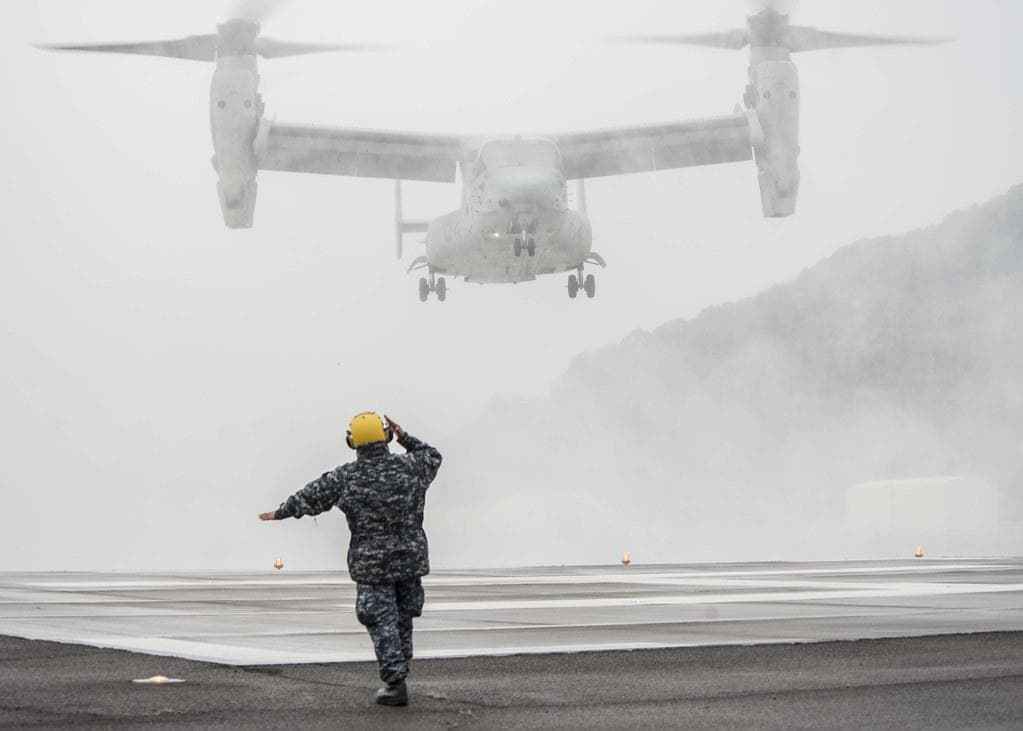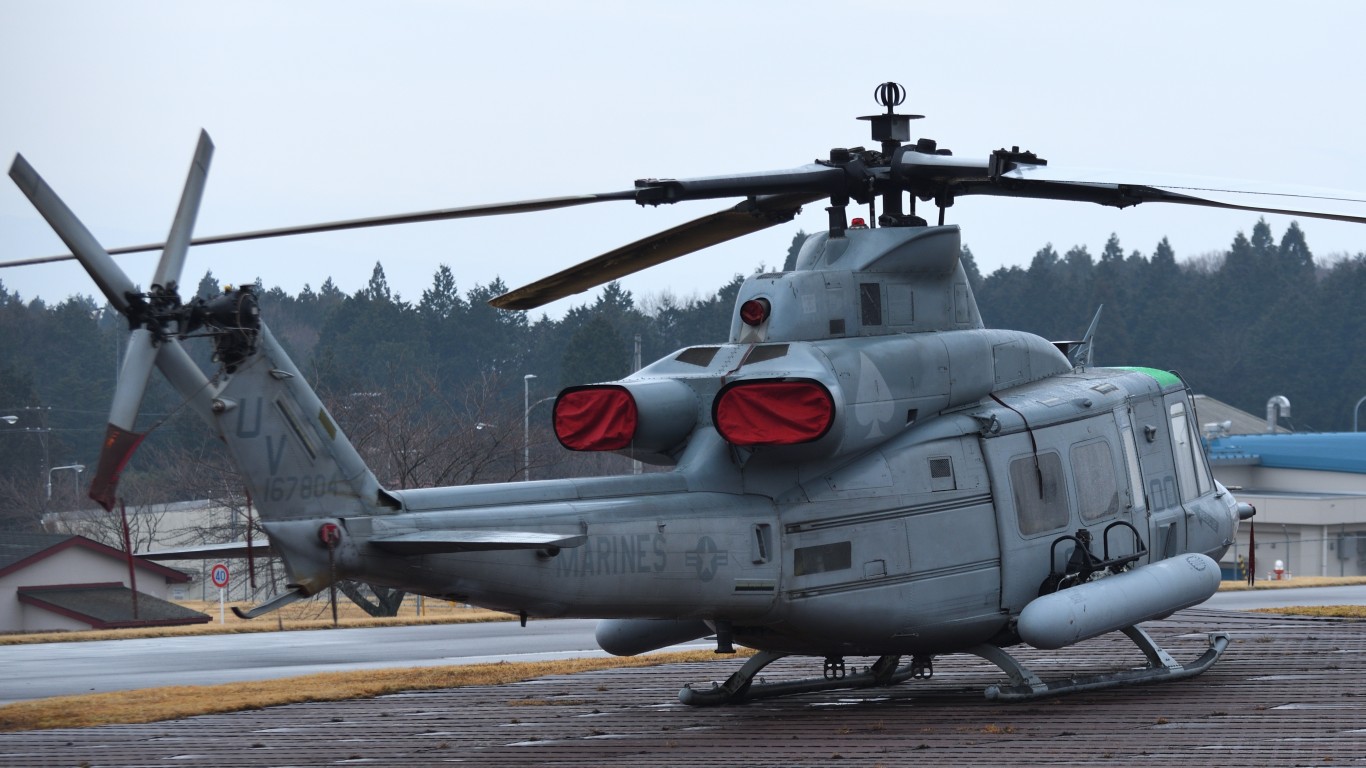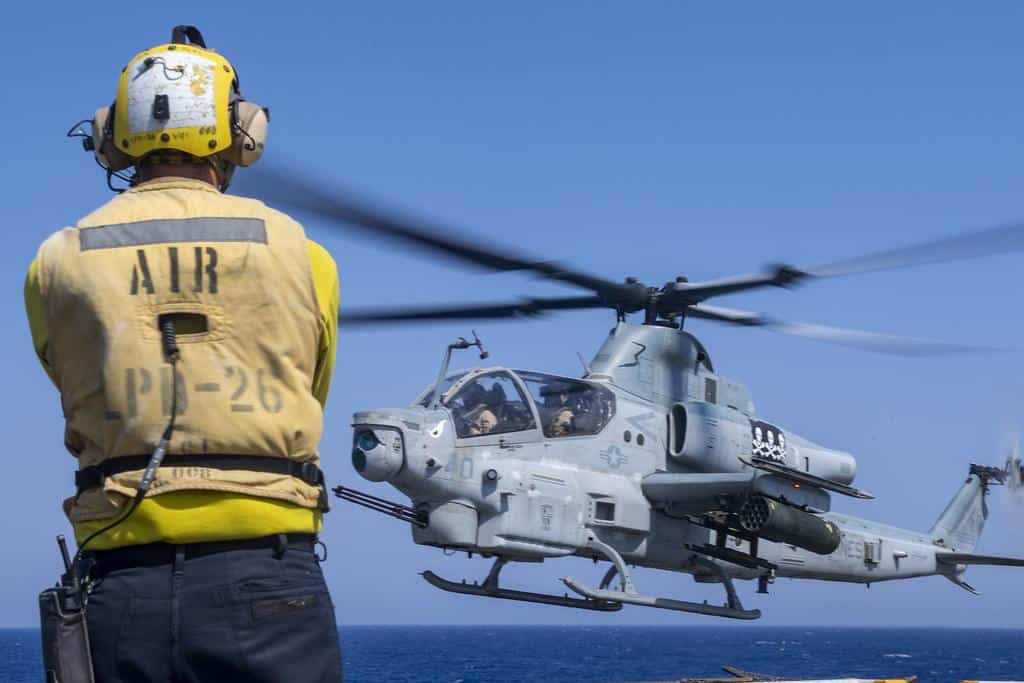
24/7 Wall St. Insights:
- The MV-22 Osprey was introduced in the mid-2000s and has become a staple of the U.S. Marine Corps
- Its unique tilt-rotor function allows for the versatility of a helicopter and the speed of a turboprop plane
- The MV-22 has a range of over 1,000 nautical miles and can carry up to 24 troops or 20,000 pounds of cargo
- Also: Discover the next Nvidia
Since its introduction to the United States Marine Corps in 2007, the MV-22 Osprey has become a staple of Marine Corps aviation. It has a storied history with the Corps and is effectively the workhorse in getting Marines to and from their objectives. (This is every gun used by the U.S. Marine Corps.)
Unlike most rotor-based aircraft, the Osprey has a unique ability. At takeoff and landing, the Osprey’s rotors are positioned vertically, functioning like a helicopter, which allows it to perform vertical takeoffs, landings, and even hovering. However, once airborne, the aircraft’s rotors gradually tilt forward until they are horizontal, effectively transforming the Osprey into a turboprop airplane.
This transformation allows the Osprey to achieve much greater speeds than conventional helicopters, and it improves the aircraft’s as well. The MV-22 has a range of over 1,000 nautical miles and can carry up to 24 troops or 20,000 pounds of cargo.
With this incredible functionality and speed, the Marine Corps put the Osprey to the test in operations across Iraq and Afghanistan. While traditional military helicopters saw their advent in the Vietnam War, the Osprey became wildly popular among Marines throughout the Global War on Terrorism.
As modern warfare continues to evolve, the Osprey has found a place in one of the fiercest fighting forces on the planet. This is just one of the many helicopters used by the U.S. Marine Corps. (This is every aircraft flown by the U.S. Marine Corps.)
24/7 Wall St. is taking a closer look at the helicopters in the arsenal of the U.S. Marine Corps. To identify every helicopter currently in service of the U.S. Marine Corps, 24/7 Wall St. reviewed data from the 2024 World Air Forces report from FlightGlobal, an aviation and aerospace industry website, and ranked the aircraft by active units. Additionally, we’ve included supplemental information on the type of aircraft, top speed, and armament.
Here is a look at every helicopter currently in the U.S. Marine Corps:
Why Are We Covering This?

On average, the U.S. spends $400 billion a year on the operation and support of its military units. In 2024, $5.7 billion was budgeted to the Marines Corps for aviation readiness. Overall, the Department of Defense has $2.02 trillion in budgetary resources which is 14.6% of the federal budget for 2024.
5. CH-53K King Stallion

- Type: Heavy-lift transport helicopter
- Year introduced: 2018
- Active aircraft: 11
- Top speed: 196 mph
- Armament: 12.7mm heavy machine guns, 12.7mm GAU-21 miniguns
4. UH-1Y Venom

- Type: Medium-lift utility / transport helicopter
- Year introduced: 2009
- Active aircraft: 127
- Top speed: 190 mph
- Armament: 7.62mm machine guns, 12.7mm GAU-16/A gatling guns, hydra rocket pods
3. CH-53E Super Stallion

- Type: Super heavy-lift transport helicopter
- Year introduced: 1981
- Active aircraft: 135
- Top speed: 196 mph
- Armament: 12.7mm heavy machine guns, 12.7mm GAU-21 miniguns
2. AH-1Z Viper
- Type: Twin-engine attack helicopter
- Year introduced: 2010
- Active aircraft: 176
- Top speed: 255 mph
- Armament: 20mm M196 cannon, Hellfire missiles, air-to-surface missiles, Sidewinder missiles, Hydra rocket pods
1. MV-22 Osprey

- Type: Tilt Rotor VTOL aircraft
- Year introduced: 2007
- Active aircraft: 288
- Top speed: 316 mph
- Armament: 7.62mm machine guns, 12.7mm machine guns
Take Charge of Your Retirement In Just A Few Minutes (Sponsor)
Retirement planning doesn’t have to feel overwhelming. The key is finding expert guidance—and SmartAsset’s simple quiz makes it easier than ever for you to connect with a vetted financial advisor.
Here’s how it works:
- Answer a Few Simple Questions. Tell us a bit about your goals and preferences—it only takes a few minutes!
- Get Matched with Vetted Advisors Our smart tool matches you with up to three pre-screened, vetted advisors who serve your area and are held to a fiduciary standard to act in your best interests. Click here to begin
- Choose Your Fit Review their profiles, schedule an introductory call (or meet in person), and select the advisor who feel is right for you.
Why wait? Start building the retirement you’ve always dreamed of. Click here to get started today!
Thank you for reading! Have some feedback for us?
Contact the 24/7 Wall St. editorial team.

